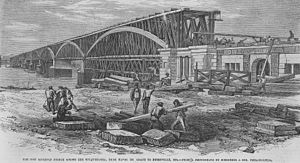P.W. & B. Railroad Bridge
P.W. & B. Railroad Bridge | |
|---|---|
 Construction of the bridge is almost complete in this 1866 newspaper illustration. | |
| Coordinates | 39°33′17″N 76°05′01″W / 39.55472°N 76.08361°W |
| Crosses | Susquehanna River |
| Locale | (ruins) Havre de Grace, Maryland and Perryville, Maryland |
| Characteristics | |
| Design | Wood truss bridge, with later iron reinforcements |
| Total length | 3,269 feet (996 m)[1]: 116 |
| No. of spans | 13 (including center draw span)[1]: 116 |
| History | |
| Opened | November 26, 1866[2] |
| Closed | 1906 (as a railroad bridge);[3] 1940 (as a highway bridge) |
| Location | |
 | |
The P.W. & B. Railroad Bridge was the first bridge over the Susquehanna River, built by the Philadelphia, Wilmington and Baltimore Railroad in 1866, as part of the first mainline railroad between Philadelphia and Baltimore. The bridge was replaced by the Susquehanna River Movable Bridge (now called the Amtrak Susquehanna River Bridge) in 1906.
History[edit]

The P.W. & B. began operating its main line in 1838, using a ferry operation to transport railroad cars over the Susquehanna River.[4]
Construction of the bridge, which was a wood truss design, began in 1862. The masonry and most of the wooden spans were complete in 1866, but then a tornado severely damaged the wooden components on July 25, 1866. Repairs were quickly made and the first locomotive crossed the bridge on November 20, 1866. The cost of construction, including rebuilding most of the truss portions, was $2.3 million. Passenger trains began service over the bridge on November 26, 1866.[2]
The P.W. & B. later replaced the wooden spans with iron spans. A draw span was then installed in the late 1870s.[2]
The Pennsylvania Railroad took control of the P.W. & B. in 1881. It built a new bridge, the Amtrak Susquehanna River Bridge, from 1904 to 1906.[3]
The P.W. & B. bridge was then converted to a vehicular bridge and was made double-decker because it was so narrow. Its existence as such overlapped that of what is now the Hatem Bridge but was eventually dismantled during World War II. The piers still stand next to the current railroad bridge today.
References[edit]
- ^ a b Roberts, Charles S.; David W. Messer (2003). Triumph VI: Philadelphia, Columbia, Harrisburg to Baltimore and Washington DC: 1827-2003. Baltimore, Maryland: Barnard, Roberts, and Co., Inc. ISBN 0-934118-28-0.
- ^ a b c Wilson, William B. (1895). History of the Pennsylvania Railroad Company. Philadelphia: Henry T. Coates & Co. pp. 310–311.
- ^ a b Baer, Christopher T. "PRR Chronology: 1906" (PDF). Retrieved 2015-06-04. Pennsylvania Railroad Technical & Historical Society.
- ^ Herbert W. Harwood, Jr. "Philadelphia, Wilmington & Baltimore Railroad". Maryland Online Encyclopedia. Maryland Historical Society. Archived from the original on July 20, 2008. Retrieved 2010-05-12.
External links[edit]
 Media related to P.W. & B. Railroad Bridge at Wikimedia Commons
Media related to P.W. & B. Railroad Bridge at Wikimedia Commons
- Bridges over the Susquehanna River
- Buildings and structures in Havre de Grace, Maryland
- Philadelphia, Baltimore and Washington Railroad
- Pennsylvania Railroad bridges
- Railroad bridges in Maryland
- Bridges in Harford County, Maryland
- Truss bridges in the United States
- Wooden bridges in the United States
- Iron bridges in the United States
- Bridges completed in 1866
- 1866 establishments in Maryland
- 1940 disestablishments in Maryland
- Philadelphia, Wilmington and Baltimore Railroad
